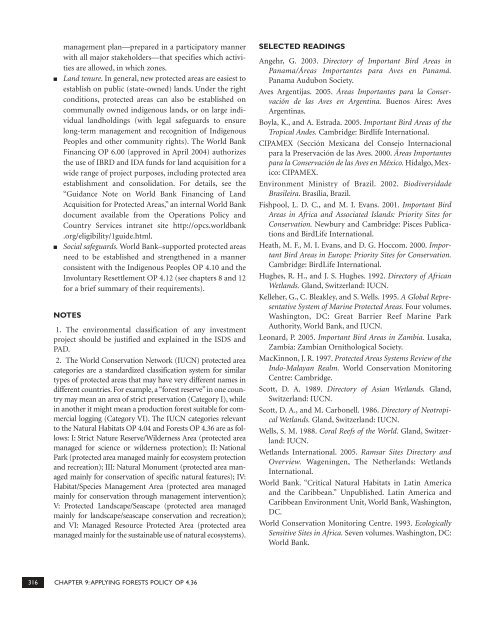Forests Sourcebook - HCV Resource Network
Forests Sourcebook - HCV Resource Network
Forests Sourcebook - HCV Resource Network
You also want an ePaper? Increase the reach of your titles
YUMPU automatically turns print PDFs into web optimized ePapers that Google loves.
■<br />
■<br />
management plan—prepared in a participatory manner<br />
with all major stakeholders—that specifies which activities<br />
are allowed, in which zones.<br />
Land tenure. In general, new protected areas are easiest to<br />
establish on public (state-owned) lands. Under the right<br />
conditions, protected areas can also be established on<br />
communally owned indigenous lands, or on large individual<br />
landholdings (with legal safeguards to ensure<br />
long-term management and recognition of Indigenous<br />
Peoples and other community rights). The World Bank<br />
Financing OP 6.00 (approved in April 2004) authorizes<br />
the use of IBRD and IDA funds for land acquisition for a<br />
wide range of project purposes, including protected area<br />
establishment and consolidation. For details, see the<br />
“Guidance Note on World Bank Financing of Land<br />
Acquisition for Protected Areas,” an internal World Bank<br />
document available from the Operations Policy and<br />
Country Services intranet site http://opcs.worldbank<br />
.org/eligibility/1guide.html.<br />
Social safeguards. World Bank–supported protected areas<br />
need to be established and strengthened in a manner<br />
consistent with the Indigenous Peoples OP 4.10 and the<br />
Involuntary Resettlement OP 4.12 (see chapters 8 and 12<br />
for a brief summary of their requirements).<br />
NOTES<br />
1. The environmental classification of any investment<br />
project should be justified and explained in the ISDS and<br />
PAD.<br />
2. The World Conservation <strong>Network</strong> (IUCN) protected area<br />
categories are a standardized classification system for similar<br />
types of protected areas that may have very different names in<br />
different countries. For example, a “forest reserve” in one country<br />
may mean an area of strict preservation (Category I), while<br />
in another it might mean a production forest suitable for commercial<br />
logging (Category VI). The IUCN categories relevant<br />
to the Natural Habitats OP 4.04 and <strong>Forests</strong> OP 4.36 are as follows:<br />
I: Strict Nature Reserve/Wilderness Area (protected area<br />
managed for science or wilderness protection); II: National<br />
Park (protected area managed mainly for ecosystem protection<br />
and recreation); III: Natural Monument (protected area managed<br />
mainly for conservation of specific natural features); IV:<br />
Habitat/Species Management Area (protected area managed<br />
mainly for conservation through management intervention);<br />
V: Protected Landscape/Seascape (protected area managed<br />
mainly for landscape/seascape conservation and recreation);<br />
and VI: Managed <strong>Resource</strong> Protected Area (protected area<br />
managed mainly for the sustainable use of natural ecosystems).<br />
SELECTED READINGS<br />
Angehr, G. 2003. Directory of Important Bird Areas in<br />
Panama/Áreas Importantes para Aves en Panamá.<br />
Panama Audubon Society.<br />
Aves Argentijas. 2005. Áreas Importantes para la Conservación<br />
de las Aves en Argentina. Buenos Aires: Aves<br />
Argentinas.<br />
Boyla, K., and A. Estrada. 2005. Important Bird Areas of the<br />
Tropical Andes. Cambridge: Birdlife International.<br />
CIPAMEX (Sección Mexicana del Consejo Internacional<br />
para la Preservación de las Aves. 2000. Áreas Importantes<br />
para la Conservación de las Aves en México. Hidalgo, Mexico:<br />
CIPAMEX.<br />
Environment Ministry of Brazil. 2002. Biodiversidade<br />
Brasileira. Brasília, Brazil.<br />
Fishpool, L. D. C., and M. I. Evans. 2001. Important Bird<br />
Areas in Africa and Associated Islands: Priority Sites for<br />
Conservation. Newbury and Cambridge: Pisces Publications<br />
and BirdLife International.<br />
Heath, M. F., M. I. Evans, and D. G. Hoccom. 2000. Important<br />
Bird Areas in Europe: Priority Sites for Conservation.<br />
Cambridge: BirdLife International.<br />
Hughes, R. H., and J. S. Hughes. 1992. Directory of African<br />
Wetlands. Gland, Switzerland: IUCN.<br />
Kelleher, G., C. Bleakley, and S. Wells. 1995. A Global Representative<br />
System of Marine Protected Areas. Four volumes.<br />
Washington, DC: Great Barrier Reef Marine Park<br />
Authority, World Bank, and IUCN.<br />
Leonard, P. 2005. Important Bird Areas in Zambia. Lusaka,<br />
Zambia: Zambian Ornithological Society.<br />
MacKinnon, J. R. 1997. Protected Areas Systems Review of the<br />
Indo-Malayan Realm. World Conservation Monitoring<br />
Centre: Cambridge.<br />
Scott, D. A. 1989. Directory of Asian Wetlands. Gland,<br />
Switzerland: IUCN.<br />
Scott, D. A., and M. Carbonell. 1986. Directory of Neotropical<br />
Wetlands. Gland, Switzerland: IUCN.<br />
Wells, S. M. 1988. Coral Reefs of the World. Gland, Switzerland:<br />
IUCN.<br />
Wetlands International. 2005. Ramsar Sites Directory and<br />
Overview. Wageningen, The Netherlands: Wetlands<br />
International.<br />
World Bank. “Critical Natural Habitats in Latin America<br />
and the Caribbean.” Unpublished. Latin America and<br />
Caribbean Environment Unit, World Bank, Washington,<br />
DC.<br />
World Conservation Monitoring Centre. 1993. Ecologically<br />
Sensitive Sites in Africa. Seven volumes. Washington, DC:<br />
World Bank.<br />
316 CHAPTER 9:APPLYING FORESTS POLICY OP 4.36

















